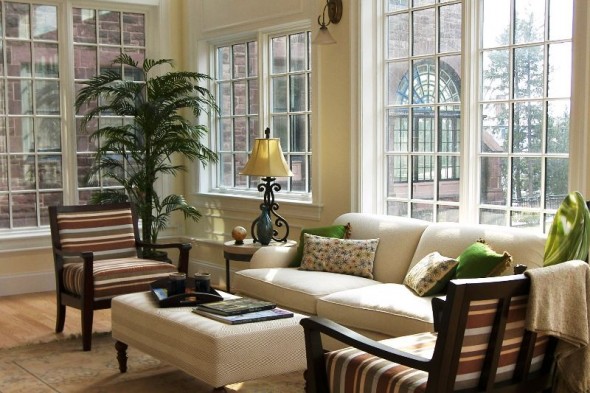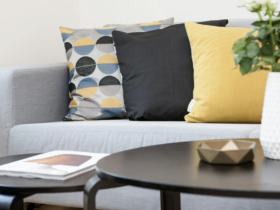Overview
New design trends continue to emerge while others fade, but a green and a healthy house remain the best of all the time. Gone are the times when housekeepers used to adorn their houses with artificial ornaments and power-consuming lighting appliances. Currently, it’s all about creating natural and inviting spaces using live plants, flowers or herbs, plus cutting down on energy use. If you are not sure about how you can incorporate natural plants and cheaper energy sources to make your house green and healthy without seeming too retro, fret not. We have plenty of ideas on how you can come up with a lovely house you will enjoy for a long time.
1. Grow Indoor Plants
Apart from turning your house attractive, use of live plants in your house is a good way to filter the air naturally. Also, there are some plants that help in absorption of harmful substances produced by home appliances such as carpets, electronics, and furniture. Some plants to make your house “green’ include palm trees, rubber plants, spider plants, and Boston ferns. You can plant them in your living room or the balcony.
Get to know more: https://www.glozine.com/home-decor/diy-herb-gardens.html
2. Allow Sunshine
One of the cheapest and most environmentally friendly sources of light and heat in your house is just outside your window. Your house should be equipped with open blinds, shutters and drapes to allow as much sunshine in as possible. Also, you can warm or light your house using sun energy by installing solar panels on the eastern and western sides of your roof. Isn’t it a good idea to cut down on your energy bills?
3. Install Carbon Monoxide Detectors
Since carbon monoxide is an odorless gas which is very harmful, poisoning can occur if you have not installed a detector. Installing a carbon monoxide detector in your house can help save lives. Thus, you should pick one from your local hardware and install it in the living room or any other place you spend a lot of time inside your house.
4. Fix Cooling and Heating Temperatures Appropriately
Your fridge and heaters are probably the biggest consumers of energy in your house. It is thus important to ensure that they are not overworking as expected. Set your fridge at 37 F and freezers at -3 F where they work at their best. Ensure their doors are closed instantly after use because leaving them open wastes some energy. Obtain an electronic thermostat to keep your house heated at a lower temperature at night and warmer in the morning.
5. Install Compact Fluorescent Bulb Lights
If you have been using the incandescent bulbs, the lighting cost of your house is four times higher than a house lit with compact florescent bulbs. Also, compact fluorescent lights last a couple of times longer than the regular types. Isn’t it a great idea to shrink your electricity bills? Also, don’t forget to turn off the lights whenever they are not in use.
6. Ban Smoking
About Gina Solomon, MD, Ph.D., a clinical associate professor of medicine at the University of California and a senior scientist at the Natural Resource Defense Counsel, banning smoking is among the most effective means to combat air pollution in your house. Equating smoking to inviting a diesel bus into your house, Solomon says cigarettes are loaded with toxic chemicals, and second-hand smoke exposure can lead to cancer.
7. Use Non-toxic Products
It is very important to find the contents in every product being used in your house. There are plenty of eco-friendly products that are devoid of harmful chemicals. For instance, you should switch to biodegradable products for cleaning your house. Alternatively, prepare your cleaning products using baking powder which is cheap and effective.
8. Compost Kitchen Wastes
Most of the kitchen wastes can be composted and used as a soil enhancer for your home garden. Put vegetable peelings, eggshells, tea leaves and any other organic material in a compost bin or pile. Add presto and water. This will not only reduce your landfill waste but also form a nutritious soil enhancer for your indoor plants.
9. Conserve Water
There are plenty of ways through which water can be conserved in your house. For example, if without contaminated soaps or detergents, water used in kitchens baths can be used to water plants in your garden. Watering plants only in the morning and evening is also a great idea to preserve water.
10. Dispose of Household Toxic Wastes
In nearly every household’s kitchen sink, garage or sinks, there are plenty of harmful substances like used oil, cans, pesticides, cleaning chemicals, damaged electronic devices, used batteries and much more. Dumping such stuff down your drain can contaminate your water supply. They will also contaminate soil if you dump them in your garden. Instead, explore on better ways to dispose toxic wastes from your household. Check if there are monthly or yearly pickups. You can also look for special drop-off sites.
Conclusion
Creating a green and a healthy home through eco-friendly means consists of cutting energy expenses and preserving the environment as well as natural resources. Apart from improving your house, changes in your daily activities can help make this planet a better place by going green. Try the above ten tips!
Reference:
1. https://www.glozine.com/home-decor
























